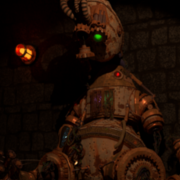I was wondering if anyone had some ideas on how I could solve this
I have a stateless particle system, where on creation of my particle emitter a buffer is filled with all the initial particle values. This includes a start position for each particle based on the position of the emitter.
Now I'm wondering how could I change the birth position of a particle, after the particle emitter is created.
I want to be able to move my particle emitter and still have any live particles stay their course, when they die/restart they then just use the newest emitter position.
I currently have a vec2 uniform ( emitterPosition ) that represents my emitters position but I definitely don't think this is enough for what I want to do.
My particles position is based on the following GLSL
vec2 position;
position.x = emitterPosition.x + (velocity.x * elapsedTime) + (0.5 * acceleration.x * pow(elapsedTime, 2.0));
position.y = emitterPosition.y + (velocity.y * elapsedTime) + (0.5 * acceleration.y * pow(elapsedTime, 2.0));
Any ideas on how I can do this that is not too crazy?





